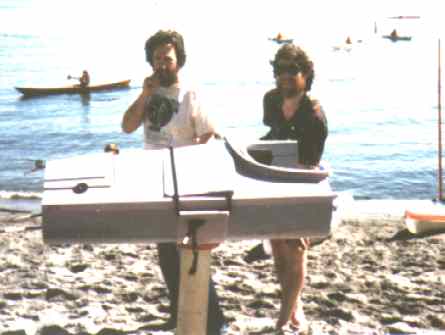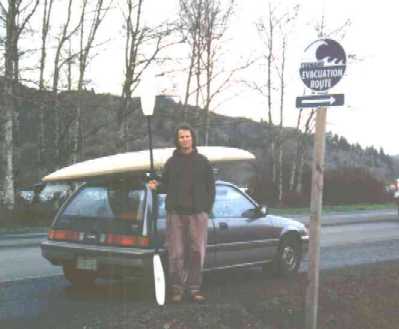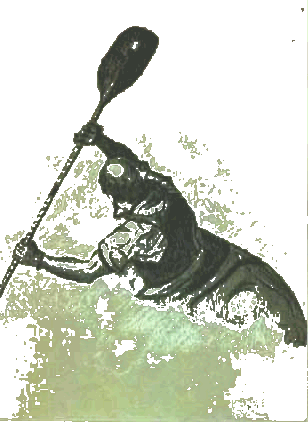I spent several years building sea kayaks back in the second half of the nineteen-eighties. It was an interesting adventure, and it was an essential part of getting me OUT of the boat-building business, but it was a mistake.
What I should have done was take the time and money that I invested in making molds and building boats out of them - which was quite a bit of money and a whole lot of time - and instead of trying to kick-start the inevitable consumer market, gone somewhere far away and had a real adventure - someplace like Belize or Costa Rica or New Zealand or Sri Lanka.
What I realized, long after the money had been spent and the molds made, was that what I needed was a folding kayak and a plane ticket to paradise, not a shop full of tools to make boats that still had to be both built and sold.
 |
In those days we were not addressing a mature market - the sport had been limping along with very few participants since I was in highschool and we were still in technology push stage in an embryonic market. Every builder in the world had to sell newcomers on the idea of kayaking in order to sell boats. One of the most catastrophic consequences of this situation was that all the boats were evolving toward the expressed needs of entry level paddlers. Which is of course doubly ironic, since these paddlers are utterly clueless as to what they actually need.
|
|
On a personal level it was also a severe compromise, because I wasn't really learning very much. I was mostly paddling with newcomers, so although I found myself in the teaching mode much of the time, I was almost always teaching the entry level people, rather than refining the skills of more experienced paddlers. In fact I rarely paddled with anyone who knew as much as me, let alone anyone who knew more than I did.
Eventually, I almost got my then-wife killed paddling in the surf at Cannon Beach, and almost immediately got another friend hurt and hypothermic, both of which were kind of inevitable, and after that summer I put the boats away for a while and in the late '80's and into the '90's I transferred the activity obsession from kayaking into Telemark Skiing.
|

|
About 5 years ago I dove back into kayaking again and last fall I was offered the opportunity to take an IDW - Instructor Development Workshop a master-class level skills demonstration course with a bunch of really good paddlers, including some people who had been running their own guiding businesses for years.
I think it was the most intense formal learning experience I have ever had and mostly what I got out of it was the knowledge that there were LOTS of techniques that I had seen put to use, and some tools that I had explored, but that now I had to practice them and learn them.
|
So I took on some students and spent a lot of the mornings this past summer on the water, teaching people what now I knew that I needed to learn. The initial realization that came from trying to teach these skills was that almost all of the features that I had been building into the entry-level boats were actually BAD for entry level paddlers because they served as training wheels that masked problems in the paddler's technique or even compensated for them and retarded the development of "real" technique.
The combination of confidence in skills one does not peosses and fundamanetally dangerous conditions one does not recognize due to over confidence is a potentially lethal brew - So I shifted everyone into white-water boats, and feathered paddles. And now we start right off undoing bad habits acquired paddling other kinds of boats and developing real technique.
|

|
When I was in college, studying Ethology and
operant psychology I ran into some of the work on the
'chaining' of events in learning - vocabulary derived from B.F. Skinner's work - and used it as the basis for teaching my Siamese cat Indole to Pee in the toilet like a person. I am using similar assesment of relationships to teach people the moves of making a whitewater kayak - basically an almost round boat at the waterline, with little initial stability and essentially no predisposition to go one direction instead of another - go in a straight line. There are really only a very fundamental things to learn and all the skills are constructed from them.
What follows is a set of instructions for how to do something. I am going to replace it with 'ficitionalization' - a description of people sitting on the beach learning how to do it - because I think that will work better. In the meantime please bear with me.
The first core events that must be chained involve overcoming the intuitive reflex to throw the mass of your torso and head from side to side in an effort to control the attitude of the boat.
That move is a sure way to get your hair wet. Instead, what is needed is to use your hips to lever the boat upright, and you must lever against the inertia of your head and torso, neither of which move.
This is a move that is very hard to understand without trying it. If I have you sit on the floor and raise one buttock without moving your head and the shoulder opposite side, you will have trouble doing it. Please try it now. Sit down on the floor and try to lif one knee and the buttock that it is connected to off the floor, then do the other. You must attempt to do it without moving your head or shoulders from side to side.
The problem that I have to address is that I really cannot expect to get people to do something unfamiliar, reliably, right away.
The solution to both of these problems - yours and mine - is to find something that will work, that you already know how to do with out having to think or learn, and teach you to use it in place of the new skill I would otherwise have to get you to practice and burn in.
I can teach you to substitute the familiar for the unfamiliar - and trust you to use it - because I know that you already know how to do it, just in a different context.
In the case ot the raised buttocks, to learn the solution you already know, please sit back down on the floor.
Now, walk backwards, one buttock at a time. You are allowed to 'rotate' your shoulders to initiate the snap. That powerful, intuitive move that you already known how to do since you were 4 years old will allow you to take the boat back from the wave that is trying to take it away from you.
To be continued ...


